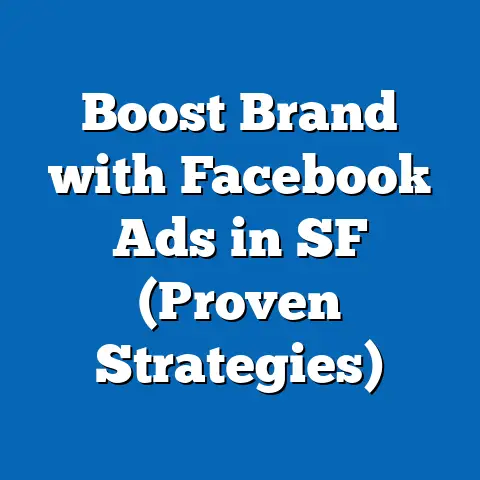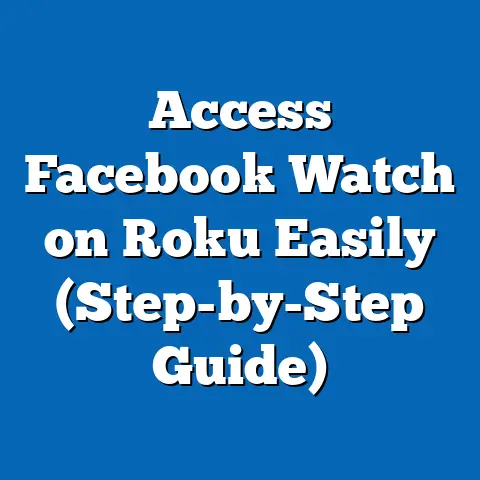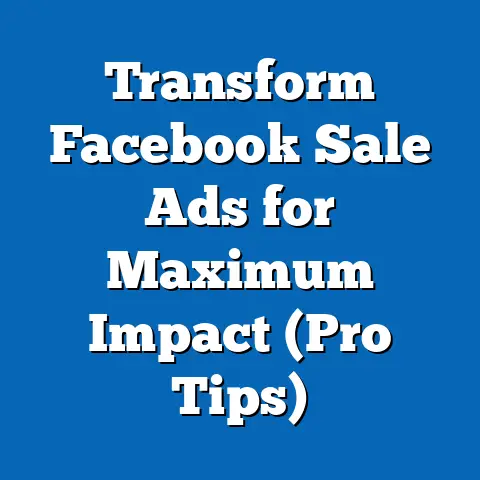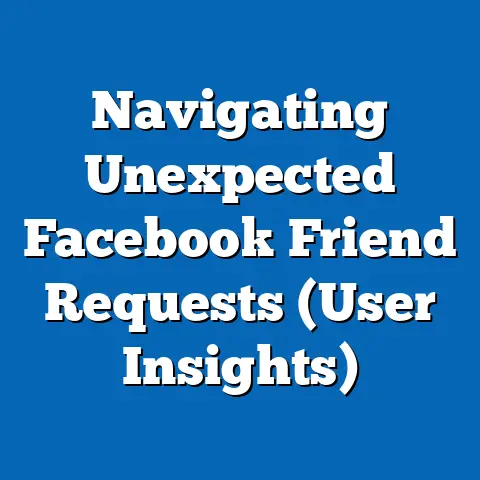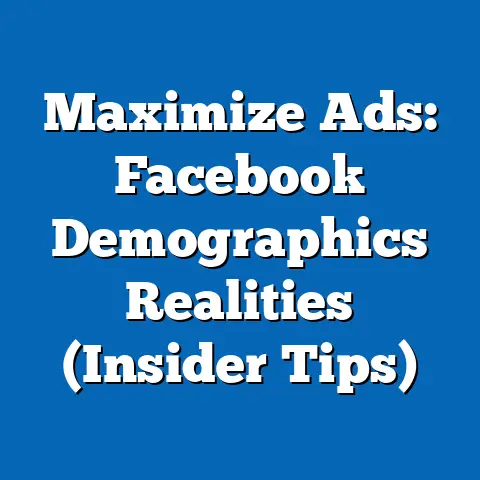Unlock True Facebook Ad Costs in Michigan (Expert Insights)
Think back to a time when advertising meant glossy magazine spreads, catchy radio jingles, or vibrant billboards lining Michigan’s highways. For many of us, those nostalgic memories of local businesses reaching out through traditional media still linger. But today, the advertising landscape has shifted dramatically, with digital platforms like Facebook becoming the cornerstone of marketing strategies for businesses of all sizes.
In Michigan, a state known for its diverse economy and vibrant small business scene, understanding the true cost of Facebook advertising is critical for marketers aiming to maximize their return on investment (ROI). According to a 2023 report by Statista, over 2.9 billion people globally use Facebook monthly, with a significant portion of Michigan’s 10 million residents active on the platform. As businesses compete for attention in this crowded digital space, ad costs can vary widely based on factors like audience targeting, industry, and geographic focus.
Section 1: The Basics of Facebook Advertising Costs
Understanding Cost Metrics
Facebook advertising operates on a pay-per-click (PPC) or cost-per-impression (CPM) model, where businesses bid for ad placements based on their target audience. In Michigan, the average cost-per-click (CPC) for Facebook ads in 2023 ranges between $0.50 and $2.00, depending on the industry and competition, according to data from WordStream’s 2023 Advertising Benchmarks report. Meanwhile, the average cost-per-thousand-impressions (CPM) hovers around $7.19, slightly below the national average of $7.50.
These costs are influenced by Facebook’s auction system, where advertisers compete for ad space based on bid amounts and ad relevance scores. A higher relevance score—determined by user engagement and ad quality—can lower costs, making creative content and precise targeting essential.
Factors Driving Costs in Michigan
Several factors impact Facebook ad costs in Michigan, including geographic density, audience demographics, and seasonal trends. Urban centers like Detroit and Grand Rapids, with higher population densities, often see elevated CPCs due to increased competition for local audiences. In contrast, rural areas may offer lower costs but reach smaller, less engaged audiences.
Seasonality also plays a role. During peak shopping seasons like the holidays, Michigan businesses report CPM spikes of up to 25%, as noted in a 2022 Hootsuite Digital Trends report. Understanding these variables is key to budgeting effectively for campaigns.
Section 2: Historical Trends in Facebook Ad Costs
A Look Back: 2018 to 2023
Facebook ad costs in Michigan have evolved significantly over the past five years, reflecting broader digital advertising trends. In 2018, the average CPC in Michigan was approximately $0.38, according to historical data from AdEspresso’s annual reports. By 2023, this figure had risen to an average of $1.25—a 229% increase—driven by growing competition and Facebook’s expanding user base.
This upward trend mirrors national patterns, where increased demand for digital ad space has pushed costs higher. However, Michigan’s costs remain slightly below the national average due to a less saturated market compared to states like California or New York.
Key Shifts in Strategy
Historically, Michigan businesses focused on broad targeting, often reaching statewide audiences with generic messaging. Over time, the adoption of hyper-local targeting—focusing on specific cities or ZIP codes—has become more prevalent, increasing ad relevance but also driving up costs in competitive areas. A 2021 study by Social Media Examiner found that 68% of Michigan marketers now use localized targeting, up from 42% in 2018.
This shift reflects a broader move toward data-driven advertising, where businesses prioritize quality over quantity in their reach. While costs have risen, so too have engagement rates, with click-through rates (CTR) in Michigan improving from 0.9% in 2018 to 1.2% in 2023, per WordStream data.
Section 3: Demographic Insights and Targeting in Michigan
Who’s Online in Michigan?
Michigan’s population of approximately 10 million is diverse, with significant variations in age, income, and online behavior that impact Facebook ad costs. According to Pew Research Center’s 2022 data, 78% of Michigan adults use Facebook, with usage highest among the 25-44 age group (84%) and lowest among those over 65 (54%). This distribution suggests that campaigns targeting younger or middle-aged adults may face higher competition and costs.
Gender differences also play a role. Women in Michigan are slightly more active on Facebook (80%) than men (76%), influencing ad costs for industries like retail or beauty, which often target female audiences. Additionally, urban areas like Detroit (82% usage) show higher engagement than rural regions (73%), per Statista’s regional breakdowns.
Income and Behavioral Patterns
Household income levels further shape targeting strategies. Michigan’s median household income of $63,202 (U.S. Census Bureau, 2022) is below the national average of $70,784, affecting purchasing power and ad response rates. Businesses targeting higher-income brackets—often in suburbs like Ann Arbor or Troy—may see higher CPCs due to competition for affluent audiences.
Behavioral data also matters. Michigan users spend an average of 38 minutes per day on Facebook, slightly above the national average of 34 minutes, according to eMarketer’s 2023 report. This extended engagement offers opportunities for advertisers but also means higher costs during peak usage times, such as evenings or weekends.
Section 4: Industry-Specific Costs in Michigan
Breaking Down Costs by Sector
Facebook ad costs in Michigan vary widely by industry due to differences in audience demand and competition. Based on 2023 data from WordStream, here are the average CPCs for key sectors:
- Retail: $0.70 CPC, driven by high consumer engagement and seasonal promotions.
- Real Estate: $1.81 CPC, reflecting intense competition for homebuyers and renters.
- Healthcare: $1.32 CPC, influenced by demand for local services and insurance plans.
- Automotive: $1.15 CPC, tied to Michigan’s historical connection to the auto industry.
- Technology: $2.14 CPC, the highest due to niche targeting and high-value conversions.
These figures highlight the importance of industry-specific strategies. Retail businesses, for instance, may benefit from lower costs but face challenges in standing out, while tech companies must budget more for premium placements.
Visualizing the Data
If visualized, a bar chart comparing CPCs across industries would clearly show technology and real estate as outliers, with retail at the lower end. Pairing this with a line graph of seasonal cost fluctuations—peaking in Q4 for retail and Q2 for real estate—would provide deeper context for planning campaigns. Such visualizations help marketers allocate budgets based on industry benchmarks and timing.
Section 5: Comparing Michigan to National Averages
Cost Disparities
While Michigan’s average CPC of $1.25 and CPM of $7.19 are below national figures ($1.72 CPC and $7.50 CPM, per WordStream 2023), the gap has narrowed over time. In 2018, Michigan’s CPC was 30% lower than the national average; by 2023, this difference shrunk to 27%, signaling growing competition within the state.
States with larger markets, like California (average CPC $2.10), consistently outpace Michigan due to higher population density and business activity. However, Michigan’s costs exceed those in less competitive states like Idaho ($0.95 CPC), reflecting its status as a mid-tier advertising market.
Engagement and ROI
Despite lower costs, Michigan’s engagement metrics are competitive. The state’s average CTR of 1.2% matches the national average, and conversion rates for e-commerce campaigns are slightly higher at 3.1% compared to 2.9% nationwide, per Shopify’s 2023 data. This suggests that while ad spend may be lower, Michigan businesses can achieve strong ROI with effective targeting.
Section 6: Methodologies and Data Sources
How Costs Are Calculated
Facebook ad costs are determined through a real-time bidding system, factoring in advertiser budgets, audience size, and ad quality. Data for this article comes from aggregated reports by WordStream, AdEspresso, and Hootsuite, which compile anonymized campaign data from thousands of advertisers. These sources use median values to account for outliers, ensuring reliable benchmarks.
Demographic data is sourced from Pew Research Center and the U.S. Census Bureau, offering a robust view of Michigan’s population dynamics. Engagement metrics are derived from eMarketer and Statista, which track user behavior across platforms.
Limitations
While these sources provide comprehensive insights, costs can fluctuate daily based on market conditions, and individual campaign results may vary. Small businesses with limited budgets may also face different challenges compared to larger advertisers, a factor not fully captured in aggregated data.
Section 7: Strategies to Optimize Ad Spend in Michigan
Targeting Tips
To manage costs, Michigan businesses should prioritize hyper-local targeting, focusing on specific communities rather than broad statewide campaigns. For example, a Detroit-based retailer could target users within a 10-mile radius, reducing competition and improving relevance. A 2022 study by Social Media Today found that localized ads in Michigan achieve 15% higher CTRs at 10% lower costs.
Creative and Timing
High-quality visuals and compelling copy are also critical. Ads with video content see 20% higher engagement in Michigan compared to static images, per Facebook’s internal 2023 data. Scheduling ads during off-peak hours—such as early mornings—can further reduce costs by avoiding high-traffic bidding wars.
Budget Allocation
Experts recommend starting with a small test budget ($50-$100) to gauge audience response before scaling up. Tools like Facebook Ads Manager provide detailed analytics on cost per result, helping businesses refine their approach. Allocating 60-70% of the budget to high-performing audiences, as suggested by Hootsuite, ensures efficient spending.
Section 8: Broader Implications and Future Trends
Economic Impact
The rising cost of Facebook ads in Michigan reflects a broader shift toward digital-first marketing, with small businesses increasingly reliant on platforms like Facebook to compete. As costs climb, access to affordable advertising may become a barrier for startups, potentially widening the gap between established companies and new entrants.
Technological Shifts
Looking ahead, advancements in AI-driven targeting and automation could further influence costs. Facebook’s ongoing updates to its algorithm, such as the 2023 rollout of enhanced privacy features, may reduce ad effectiveness for some campaigns, prompting higher bids. A 2023 Forrester report predicts a 10-15% cost increase over the next two years as advertisers adapt to these changes.
Opportunities for Growth
Despite challenges, Michigan’s digital advertising landscape offers significant opportunities. The state’s diverse demographics and growing online engagement—up 5% since 2020, per eMarketer—provide fertile ground for innovative campaigns. Businesses that invest in data-driven strategies and creative excellence will likely see sustained growth, even as costs rise.
Conclusion: Navigating the Future of Facebook Ads in Michigan
Understanding the true cost of Facebook advertising in Michigan is more than a numbers game—it’s about aligning budgets with strategic goals in a dynamic digital environment. From an average CPC of $1.25 to industry-specific variations and demographic nuances, the data reveals a complex but navigable landscape for advertisers. Historical trends show costs rising over time, yet Michigan remains a cost-effective market compared to national averages, offering strong ROI potential.
As competition intensifies and technology evolves, businesses must stay agile, leveraging localized targeting, high-quality content, and data analytics to optimize their ad spend. The broader implications point to a future where digital advertising will continue to shape Michigan’s economic and cultural fabric, rewarding those who adapt with precision and creativity. Whether you’re crafting a campaign for a local shop in Lansing or a statewide initiative, the insights in this guide provide a roadmap to success in the ever-changing world of Facebook ads.


